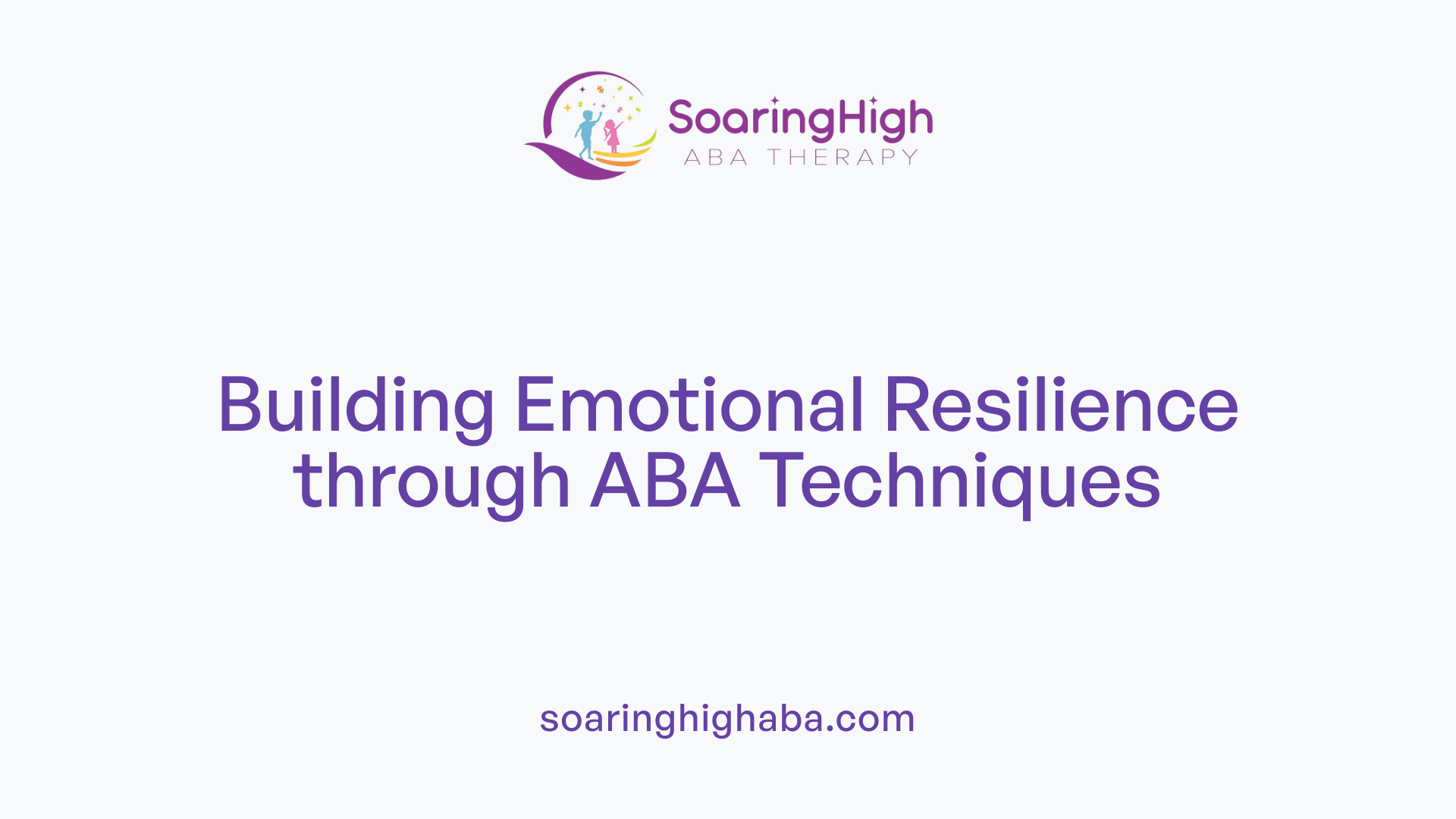Understanding ABA's Role in Emotional Regulation Support
Applied Behavior Analysis (ABA) is a scientifically validated approach focusing on understanding behavior and implementing tailored strategies to foster meaningful change. Particularly for individuals with autism spectrum disorder (ASD), ABA therapy has evolved to emphasize not just behavior modification but also the development of essential emotional regulation (ER) skills crucial for social integration and daily functioning.
Methods and Strategies in ABA for Emotional Regulation

What methods and strategies are used in ABA therapy to improve emotional regulation?
Applied Behavior Analysis (ABA) therapy utilizes a variety of practical, evidence-based strategies designed to enhance emotional regulation in individuals with autism spectrum disorder (ASD). One fundamental approach involves teaching children to identify and label their emotions using visual aids such as emotion cards, social stories, and programs like the Zones of Regulation. These tools help children understand and communicate their feelings more effectively.
Role-playing and modeling are also common techniques. Therapists demonstrate appropriate emotional responses in simulated scenarios to help children observe and imitate positive behaviors. This experiential learning fosters better understanding of social and emotional cues.
Task analysis is employed to teach specific coping strategies, such as deep breathing exercises, requesting breaks, or engaging in calming activities. By breaking down these skills into smaller, manageable steps, children can gradually build their capacity for emotion regulation.
Visual supports play a vital role in this process. Tools like calm down cards, visual menus, and color-coded scales from the Zones of Regulation program allow children to recognize their emotional states and select suitable calming strategies. These supports serve as cues that promote self-awareness and control during emotional distress.
Reinforcement techniques are used extensively to encourage and sustain positive emotional responses. For instance, when a child successfully uses a coping strategy or demonstrates calm behavior, they receive praise or tangible rewards, reinforcing these adaptive skills.
Proactive supports play a preventative role. Visual schedules, sensory tools (like fidget toys), and choice boards help reduce environmental triggers that might provoke emotional outbursts. Creating predictable routines and offering sensory accommodations help children feel more secure and less likely to become overwhelmed.
Additionally, parent training and collaboration across multiple settings are crucial. By ensuring consistency in strategies used at home, school, and therapy sessions, children receive cohesive support that facilitates the generalization and maintenance of emotion regulation skills over time.
Through these comprehensive strategies, ABA therapy aims to equip children with ASD with the skills necessary to understand, express, and manage their emotions effectively, leading to improved social interactions and reduced behavioral challenges.
Tailoring ABA Therapy to Support Emotional Regulation Skills
How is ABA therapy tailored to support emotional regulation skills?
ABA therapy adapts to the unique needs of each individual to promote better emotional regulation. This is achieved through detailed assessments of emotional triggers, often using Functional Behavior Assessments (FBAs), which help identify specific circumstances or stimuli that provoke emotional responses.
Once triggers are understood, therapists implement structured teaching methods focused on emotional awareness. They introduce strategies like modeling appropriate responses and role-playing scenarios that help individuals recognize and understand their own feelings.
Visual supports play a central role in teaching emotional skills. Tools such as emotion cards, social stories, and visual routines like the Zones of Regulation help children identify their emotional states and learn suitable responses. These concrete aids make abstract concepts more accessible.
Functional Communication Training (FCT) is a key component of ABA tailored interventions. FCT teaches children to express their needs or frustrations through words, gestures, or communication devices instead of reacting aggressively or through outbursts. This reduces common challenging behaviors in ASD, such as tantrums and aggression.
Reinforcement strategies are used extensively in ABA therapy. When children practice calm, appropriate responses or successfully use communication tools, they receive positive reinforcement. This process encourages the repetition of these adaptive behaviors, gradually building strong emotional regulation skills.
Collaboration with families and caregivers ensures consistency across all environments. Therapists work closely with parents, teachers, and other professionals to develop and implement strategies that reinforce emotional regulation at home, in school, and during community activities.
In addition, the incorporation of visual supports, like emotion cards and adaptable routines, helps children anticipate and manage emotional changes, especially during seasonal shifts or social events. These supports serve as constant reference points, guiding children toward appropriate emotional responses.
Overall, ABA therapy's individualized approach ensures that children learn to navigate their emotions effectively, reducing negative behaviors and fostering social and emotional growth in daily life.
Supporting Individuals During Challenging or Transitional Emotional Periods
How does ABA therapy assist individuals with autism during challenging or transitional emotional periods?
ABA (Applied Behavior Analysis) therapy plays a vital role in helping individuals with autism manage difficult or transitional emotional situations. It focuses on teaching skills that enable them to identify and understand their own emotions more effectively.
One of the main strategies used in ABA is the use of visual aids such as emotion cards and social stories. These tools help individuals recognize different emotional states and understand appropriate responses. Modeling behavior is also central, where therapists demonstrate emotionally regulated responses for individuals to imitate.
To prepare for changes and reduce anxiety, ABA incorporates visual schedules and social stories that outline upcoming transitions, like changing routines or seasonal shifts. Graded exposure techniques gradually introduce new or challenging environments, fostering adaptability.
Reinforcement is critical. When a person responds positively to a transition or uses coping strategies like deep breathing or requesting a break, they receive praise or rewards. This positive reinforcement encourages repeated use of these adaptive behaviors.
Building emotional resilience is essential. ABA supports this by teaching flexibility in thinking and behavior, helping children develop confidence in facing new or difficult situations.
Parents and caregivers are integral to this process. Parent training ensures that strategies used in therapy are reinforced consistently across home and community settings. This continuity helps generalize skills and creates a supportive environment for emotional growth.
In addition to teaching emotional awareness, ABA incorporates personalized approaches tailored to each individual’s needs. This includes addressing sensitivities related to seasonal or environmental changes, such as summer heat or winter cold. Techniques like visual menus and coping strategies such as deep breathing, taking breaks, and gradual exposure help children manage these shifts.
Overall, ABA therapy’s structured, evidence-based methods aim to enhance emotional regulation, increase resilience, and foster confidence. This comprehensive approach helps individuals with autism navigate transitions smoothly, reducing frustration and promoting better adaptation.
The Effectiveness and Research Behind ABA for Emotional Regulation
What research supports ABA therapy techniques for emotional regulation?
Research has established a solid foundation of evidence supporting ABA (Applied Behavior Analysis) techniques as effective tools for improving emotional regulation in children with autism spectrum disorder (ASD). These methods include structured teaching, positive reinforcement, visual supports, social stories, modeling, role-playing, and discrete trial training.
Studies show that ABA interventions, especially when tailored to individual needs, significantly enhance a child's ability to recognize, understand, and manage their emotions. Parent-implemented ABA strategies have demonstrated strong empirical support, leading to improvements not only in emotional regulation but also in social and communication skills, as well as daily living abilities.
Furthermore, targeted ABA programs are effective in reducing maladaptive behaviors such as tantrums, aggression, and self-injury, which often stem from difficulties in emotional regulation. Visual tools like emotion cards and programs like the Zones of Regulation help children identify and label their feelings, facilitating better coping strategies.
The scientific literature highlights that ABA’s focus on observable behaviors and measurable outcomes makes it a validated intervention for emotional regulation. These therapies are particularly beneficial when they incorporate behavioral assessments like Functional Behavior Assessments (FBAs) and involve active collaboration with families to develop individualized intervention plans.
Overall, widespread research supports the use of ABA to teach emotional skills, promote adaptive behaviors, and support long-term development in children with ASD.
Supporting Emotional Development Across Contexts and Seasons
How does ABA therapy support emotional regulation during seasonal or environmental changes?
ABA therapy plays a vital role in helping children adapt emotionally to changing seasons and environments. One of its main strategies involves establishing clear and flexible routines. These routines provide a sense of predictability, which is essential for reducing anxiety and frustration that can arise during seasonal shifts, such as transitioning into winter or summer.
Therapists use visual supports like emotion cards, social stories, and the Zones of Regulation program. These tools help children recognize and understand their feelings in response to environmental changes, such as feeling chilly in winter or overwhelmed by sunlight in summer.
Reinforcement is employed to encourage calm and adaptive responses. For instance, children might receive praise or rewards when they manage discomfort or express their feelings appropriately.
Preparing children for seasonal changes involves explicit teaching of coping skills like wearing appropriate clothing or adjusting to different outdoor conditions. These skills are often taught through gradual exposure and role-playing scenarios, making transitions smoother.
Social skills training also plays a part. It equips children to participate in seasonal activities, such as holiday celebrations or outdoor summer play, with confidence. This preparation involves practicing expected behaviors and communication strategies relevant to each season.
Family involvement is crucial. Parents are guided to maintain routines, facilitate communication, and provide consistent support during seasonal transitions. Open discussions about feelings and anticipations help children process change effectively.
Overall, ABA therapy leverages a combination of visual supports, behavioral reinforcement, social skills training, and family collaboration to support emotional regulation. These approaches help children navigate environmental changes with less stress and increased emotional resilience.
The Integral Role of Families and Professionals in Supporting Emotional Regulation
What is the role and effectiveness of ABA therapy in managing emotions for individuals with autism spectrum disorder?
Applied Behavior Analysis (ABA) therapy serves as a cornerstone intervention for helping individuals with autism spectrum disorder (ASD) manage their emotions more effectively. This evidence-based approach emphasizes understanding specific emotional triggers and teaching appropriate responses through structured techniques.
Therapists utilize visual supports such as emotion cards and social stories, along with reinforcement strategies, to facilitate emotional recognition and regulation. For example, programs like the Zones of Regulation use a color-coded scale to help individuals identify their emotional state and respond appropriately.
The collaborative nature of ABA involves assessing individual needs with tools like Functional Behavior Assessments to uncover triggers. Based on these assessments, therapists design personalized plans that focus on developing coping strategies, such as deep breathing, taking breaks, or using visual menus. These methods aim to help individuals manage emotional outbursts like tantrums or aggression.
Research consistently demonstrates the effectiveness of ABA in this area. It shows that when interventions are tailored to each child's developmental level and needs, they lead to noteworthy improvements in emotional control, social skills, and overall adaptive behavior.
Regular collaboration with family members, educators, and other professionals is essential. This teamwork ensures consistency across environments, reinforcing emotional regulation skills learned during therapy. Training parents and caregivers in the same strategies used during therapy sessions enhances generalization of skills.
In summary, ABA therapy not only addresses behaviors associated with ASD but also significantly contributes to emotional well-being. Its structured, individualized approach fosters understanding and mastery of emotional regulation, leading to more resilient and socially competent individuals.
Ensuring Lasting Skills Through Consistent, Evidence-Based Practice
ABA therapy’s focus on evidence-based strategies, individualized approaches, and collaborative efforts with families and educators creates a comprehensive framework for developing emotional regulation skills in individuals with ASD. While ongoing research continues to refine these techniques, the current evidence underscores ABA’s effectiveness in managing challenging emotions, fostering resilience, and promoting adaptive behaviors essential for social participation and quality of life.
References
- Emotional Regulation Challenges with ABA Therapy in Riverside, CA
- Emotion Regulation: Concepts & Practice in Autism Spectrum Disorder
- Practical Strategies to Teach Emotional Regulation Skills in ABA ...
- How ABA Therapy Helps with Seasonal Changes in Richmond
- [PDF] Emotional Regulation Strategies
- Emotional Regulation Aba | TPT
- From Meltdowns to Calm:ABA Therapy Strategies for Managing ...
- Teaching Emotional Regulation with ABA Tools
- ABA Therapy for Emotional Regulation: From Meltdowns to Mastery





































































































